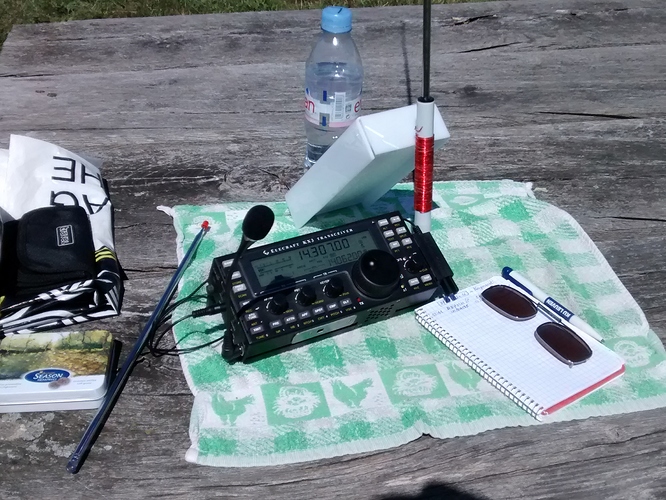All,
One of the more subtle things not mentioned so far is multi-band operation, and fast band changes.
With the better small rigs, it’s possible to jump from band to band to catch S2S contacts that would otherwise be missed. Even with an auto-tuner, some antennas work a lot better than others on the more popular 40-30-20-17-15M bands.
Any simple coax-fed dipole will have mismatch problems and coax loss on some bands if fed with RG-174 or other small line. Using traps is one way to reduce the mismatch loss.
One of the big advantages of the end-fed wires is that because there’s no coax feeder, there’s no coax loss. The feed impedance depends on the main wire length, the counterpoise length (if used), and other factors, but good tuners can easily match these wires on all the 40-30-20-17-15M bands and more.
These days I often carry two different antenna systems on most activations.
-
66 feet of #24 silver-plated teflon wire with a link (jumper) at 52 feet. Usually I use no counterpoise with this. My support pole is about 18 feet high, so about 48 feet of wire remain to be run out to another support.
-
52 feet of the same wire, with links at 46 feet and 33 feet. Usually I use a 12-foot counterpoise with this. The support pole is 18 feet high, so about 34 feet of wire remain to run out to something. This more compact antenna helps when space is limited. I cannot detect any reduction in performance compared to the 66-foot wire.
I use a homebrew manual tuner with both systems, and I can easily tune 40 through 15 meters with either antenna.
Some of the matches are resonant high-Z matches, such as the 66-foot wire on 40, 20, an 15M. The 52-foot wire is resonant with the 12-foot counterpoise on 40 and 20M, but the impedances are moderate, requiring use of different taps on the tuner’s tank circuit. The 52-foot wire presents a high-Z match on 30M and 17M, so the counterpoise has little effect on those bands.
By opening a link, I can have other matches available if I like. One of the nice features of the end-fed-on-a-pole is that you can often just tilt the pole to lower the wire, so it’s easy to open or close a link. There is just one link to change, instead of two as on a dipole.
When activating high, alpine summits far above timberline - sometimes above 4000M - with strong gusty winds, the end fed is the only effective antenna that I am able to deploy. Wires blow in the wind, along with everything else, but many times a single wire can be strung in the direction of the wind, or opposite, to great advantage. Often a pole can be supported by rocks, or 2 or 3 simple guys, and the wire helps stabilize it. I have run these simple systems in winds so powerful that I feared the pole would gyrate to destruction - and well it might - but anything else would have been long gone!
It is almost magical to hear the flying wire singing with the gusts, and the pole humming loudly as it dances, and sit in a hole down in the rocks and work station after station as they call from all over!
With these systems I usually don’t have to get up to change bands, so looking for S2S activators is pretty fast. A perfect match is not needed to listen with these wires. Once you know where your matches are for each band, preparing to transmit just takes a few seconds. A good LED bridge in the tuner is the key.
73
George
KX0R
